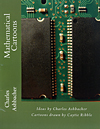- About MAA
- Membership
- MAA Publications
- Periodicals
- Blogs
- MAA Book Series
- MAA Press (an imprint of the AMS)
- MAA Notes
- MAA Reviews
- Mathematical Communication
- Information for Libraries
- Author Resources
- Advertise with MAA
- Meetings
- Competitions
- Programs
- Communities
- MAA Sections
- SIGMAA
- MAA Connect
- Students
- MAA Awards
- Awards Booklets
- Writing Awards
- Teaching Awards
- Service Awards
- Research Awards
- Lecture Awards
- Putnam Competition Individual and Team Winners
- D. E. Shaw Group AMC 8 Awards & Certificates
- Maryam Mirzakhani AMC 10 A Awards & Certificates
- Two Sigma AMC 10 B Awards & Certificates
- Jane Street AMC 12 A Awards & Certificates
- Akamai AMC 12 B Awards & Certificates
- High School Teachers
- News
You are here
Mathematical Cartoons

Publisher:
Charles Ashbacher and associates
Publication Date:
2015
Number of Pages:
59
Format:
Paperback
ISBN:
9781514207130
Category:
General
[Reviewed by , on ]
David S. Mazel
08/10/2015
Charles Ashbacher was the editor of the Journal of Recreational Mathematics for its last eight volumes. During his tenure, Ashbacher sought cartoons related to mathematics and not having found many to his liking, Ashbacher put together this book.
Let’s start with the obvious: Mathematical Cartoons is a silly, goofy, minimalist book of cartoons. If you flip through the pages, you will probably wonder why anyone would write, not to mention publish, such a collection of cartoons. And yet, after reviewing each cartoon, reading the explanations in the back (they are concise and well-done) and rereading the cartoons a few times, the idea grew on me. Charles Ashbacher has put together a fun book that meets his goal of expressing various mathematical ideas in a light-hearted and clever way.
The cartoons are at times funny, at other times simply silly, but they are all mathematical and worth some attention. A silly cartoon, for example, is the die on a scale weighing one gram. The caption is “Dieagram.” Likewise, the cartoon of three dice increasing in size one to the other has the caption “Dielation.”
The “Catenary Curve” showing a canary with the face of a cat perched on a catenary curve is pretty good. The “Trimonster” shows us the number of elements in a sporadic finite simple group, the monster group, written in a Y-like shape with each leg composed of: \[2^{46} \cdot 3^{20} \cdot 5^{9}\cdot 7^{6} \cdot 11^{2} \cdot 13^{2}\cdot 17 \cdot 19\cdot 23\cdot 31\cdot 41\cdot 47\cdot 59\cdot 71\]
“Mathematical Cows” is a cartoon of a hillside with three cows saying “moo” but with the Greek symbol mu (\(\mu\)) in the callout boxes. There is “Circulant,” a cartoon with the fraction \(1/7\) surrounded by a radix point and a circular shape of digits: \(142857142857142857\). The explanation is:
Circulant — the fraction \(1/7\) has the repeating decimal value \(0.142857\), in this cartoon a circle is formed that repeats this indefinitely. The term “circulant” refers to a matrix where the rows offset-repeat a sequence of numbers.
I could have done without “Serpentine Curve,” a drawing of a snake with the caption formed with snake-like letters.
My favorite cartoon is “A Doubly True Integration:” \[\int \frac{d \; \text{ical}}{\text{ical}} = \log \; \text{ical}\]
The book contains 50 cartoons in all. I suspect everyone will find at least one to his/her liking and maybe even derive a smile from the others.
David S. Mazel is a practicing engineer in Washington, DC. He welcomes your thoughts and comments and can be reached at mazeld at gmail dot com.
The table of contents is not available.
- Log in to post comments




